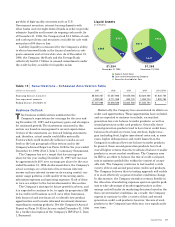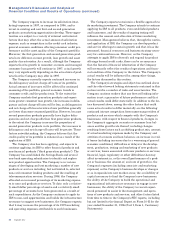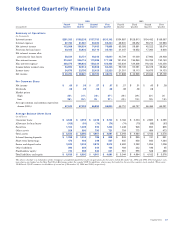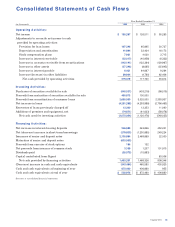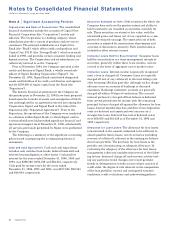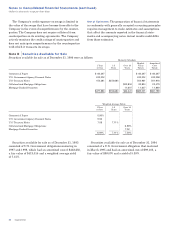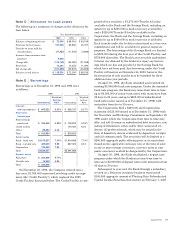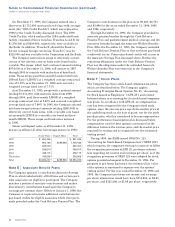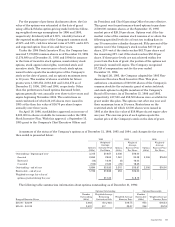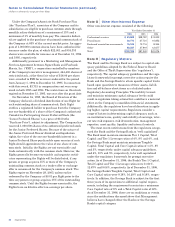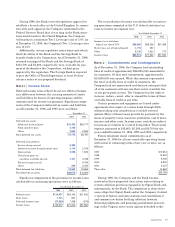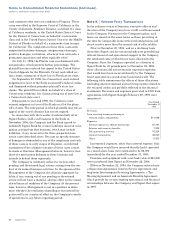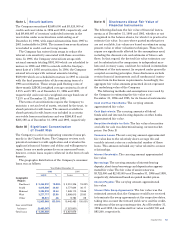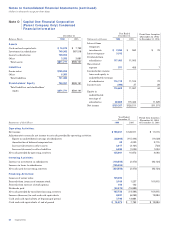Capital One 1996 Annual Report Download - page 47
Download and view the complete annual report
Please find page 47 of the 1996 Capital One annual report below. You can navigate through the pages in the report by either clicking on the pages listed below, or by using the keyword search tool below to find specific information within the annual report.Capital One 45
Solicitation: The Company expenses the costs related to
the solicitation of new accounts as incurred.
Credit Card Fraud Losses: The Company experiences fraud
losses from the unauthorized use of credit cards.
Transactions suspected of being fraudulent are charged to
non-interest expense after a 60-day investigation period.
Income Taxes: Deferred tax assets and liabilities are deter-
mined based on differences between the financial reporting
and tax bases of assets and liabilities and are measured
using the enacted tax rates and laws that will be in effect
when the differences are expected to reverse.
Earnings Per Share: Earnings per share are based on the
weighted average number of common and common equiva-
lent shares, including dilutive stock options and restricted
stock outstanding during the year, after giving retroactive
effect to the initial capitalization of the Company as if the
issuance of all shares had occurred on January 1, 1994.
Income that would have been generated from the proceeds
of the Company’s common stock on November 22, 1994 was
not considered in the calculation of earnings per share.
Interest Rate Sw ap Agreements: The Company enters into
interest rate swap agreements (“swaps”) for purposes of
managing its interest rate sensitivity. The Company desig-
nates swaps to on-balance sheet instruments to alter the
interest rate characteristics of such instruments and to
modify interest rate sensitivity. The Company also desig-
nates swaps to off-balance sheet items to reduce the inter-
est rate sensitivity associated with off-balance sheet cash
flows (i.e., securitizations).
Swaps involve the periodic exchange of payments over
the life of the agreements. Amounts received or paid on
swaps that are used to manage interest rate sensitivity and
alter the interest rate characteristics of on-balance sheet
instruments or reduce interest rate sensitivity associated
with off-balance sheet items are recorded on an accrual
basis as an adjustment to the related income or expense of
the item to which the agreements are designated. The
related amount receivable from counterparties of $41,548
and $26,652 as of December 31, 1996 and 1995, respectively,
was included in other assets. Changes in the fair value of
swaps are not reflected in the accompanying financial
statements.
Securitizations: The Company securitizes credit card loans
and records such securitizations as sales in accordance
with Statement of Financial Accounting Standards (“SFAS”)
No. 77, “Reporting by Transferors for Transfers of
Receivables with Recourse.” Due to the relatively short
average life of credit card loans securitized (approximately
8 to 12 months), no gains are recorded at the time of sale.
Rather, excess servicing fees related to the securitizations
are recorded over the life of each sale transaction. The
excess servicing fee is based upon the difference between
finance charges received from the cardholders less the yield
paid to investors, credit losses and a normal servicing fee,
which is also retained by the Company. In accordance with
the sale agreements, a fixed amount of excess servicing fees
is set aside to absorb potential credit losses. Accounts
receivable from securitization principally represents excess
servicing fees earned and due to the Company. Transaction
expenses are deferred and amortized over the reinvestment
period of the transaction as a reduction of loan servicing
fees. The monthly pattern of recording loan servicing fees is
similar to the revenue recognition that the Company would
have experienced if the loans had not been securitized.
In June 1996, the Financial Accounting Standards
Board (“FASB”) issued SFAS No. 125 (“SFAS 125”),
“Accounting for Transfers and Servicing of Financial Assets
and Extinguishments of Liabilities,” which establishes the
accounting for certain financial asset transfers including
securitization transactions. SFAS 125 requires an entity,
after a transfer of financial assets that meets the criteria
for sale accounting, to recognize the financial and servicing
assets it controls and the liabilities it has incurred and to
derecognize financial assets for which control has been
surrendered. The provisions of SFAS 125 are effective
January 1, 1997. Based on the anticipated performance of
securitization transactions the Company has undertaken,
the Company does not believe the adoption of the new
standard will have a material impact on the Company’s
financial statements.
Premises and Equipment: Premises and equipment are
stated at cost less accumulated depreciation and amortiza-
tion ($99,104 and $61,452 as of December 31, 1996 and
1995, respectively). Depreciation and amortization expense
are computed generally by the straight-line method over
the estimated useful lives of the assets.


